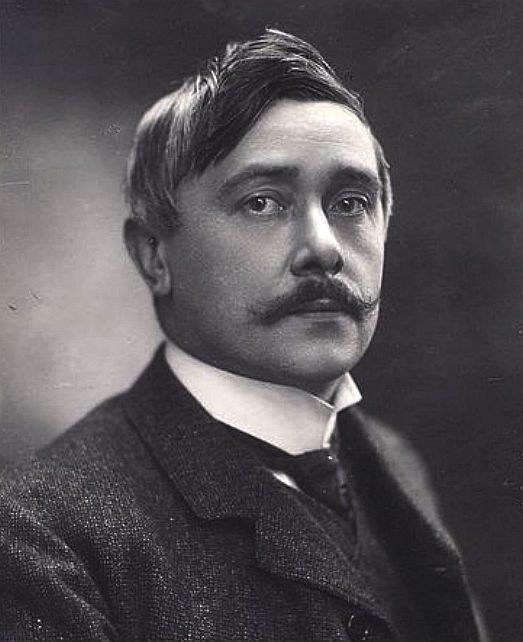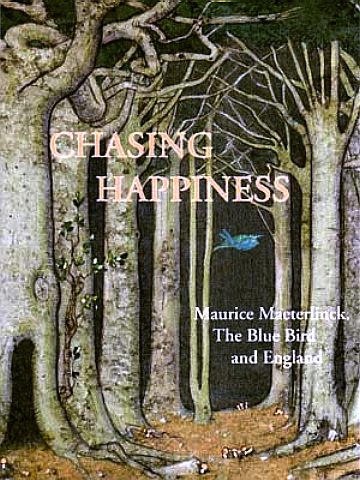|

Maurice Polydore Marie Bernard
Maeterlinck (also called Comte (Count) Maeterlinck from 1932; 29 August 1862 – 6 May 1949) was a Belgian playwright, poet, and essayist who wrote in French. He was awarded the Nobel Prize in Literature in 1911. The main themes in his work are death and the meaning of life. His plays form an important part of the Symbolist movement.
Maeterlinck instantly became a public figure when his first play, Princess Maleine, received enthusiastic praise from Octave Mirbeau, the literary critic of Le Figaro in August 1890. In the following years, he wrote a series of symbolist plays characterized by fatalism and mysticism, most importantly Intruder (1890), The Blind (1890) and Pelléas and Mélisande (1892).
He had a relationship with the singer and actress Georgette Leblanc from 1895 till 1918. Leblanc influenced his work for the following two decades. With the play Aglavaine and Sélysette Maeterlinck began to create characters, especially female characters, more in control of their destinies. Leblanc performed these female characters on stage. Even though mysticism and metaphysics influenced his work throughout his career, he slowly replaced his Symbolism with a more existential style.
In 1895, with his parents frowning upon his open relationship with an actress, Maeterlinck and Leblanc moved to the district of Passy in Paris. The Catholic Church was unwilling to grant her a divorce from her Spanish husband. They frequently entertained guests, including Mirbeau, Jean Lorrain, and Paul Fort. They spent their summers in Normandy. During this period, Maeterlinck published his Twelve Songs (1896), The Treasure of the Humble (1896), The Life of the
Bee (1901), and Ariadne and Bluebeard (1902).
In 1903, Maeterlinck received the Triennial Prize for Dramatic Literature from the Belgian government. During this period, and down to the Great War, he was widely looked up to, throughout Europe, as a great sage, and the embodiment of the higher thought of the time.
In 1906, Maeterlinck and Leblanc moved to a villa in Grasse. He spent his hours meditating and walking. As he emotionally pulled away from Leblanc, he entered a state of depression. Diagnosed with neurasthenia, he rented the Benedictine Abbey of St. Wandrille in Normandy to help him relax. By renting the abbey he rescued it from the desecration of being sold and used as a chemical factory and thus he received a blessing from the Pope. Leblanc would often walk around in the dress of an abbess; he would wear roller skates as he moved about the house. During this time, he wrote his essay "The Intelligence of Flowers" (1906), in which he expressed sympathy with socialist ideas. He donated money to many workers' unions and socialist groups. At this time he conceived his greatest contemporary success: the fairy play The Blue Bird (1908, but largely written in 1906). After the writing "The Intelligence of Flowers", he suffered from a period of depression and writer's block. Although he recovered from this after a year or two, he was never so inventive as a writer again. His later plays, such as Marie-Victoire (1907) and Mary Magdalene (1910), provided with lead roles for
Leblanc, were notably inferior to their predecessors, and sometimes merely repeat an earlier formula. Leblanc, clearly, was no longer an inspiration to the playwright. Even though alfresco performances of some of his plays at St. Wandrille had been successful, Maeterlinck felt that he was losing his privacy. The death of his mother on 11 June 1910 added to his depression.
In 1910 he met the 18-year-old actress Renée Dahon during a rehearsal of The Blue Bird. She became his lighthearted companion. Winning the Nobel Prize for Literature also served to lighten his spirits. By 1913, he was more openly socialist and sided with the Belgian trade unions against the Catholic party during a
strike. He began to study mysticism and lambasted the Catholic Church in his essays for misconstruing the history of the universe. By a decree of 26 January 1914, his opera omnia were placed on the Index Librorum Prohibitorum by the Roman Catholic Church.
When Germany invaded Belgium in 1914, Maeterlink wished to join the French Foreign Legion, but his application was denied due to his age. He and Leblanc decided to leave Grasse for a villa near Nice, where he spent the next decade of his life. He gave speeches on the bravery of the Belgian people and placed guilt upon all Germans for the war. Although his patriotism, and his indifference to the harm he was doing to his standing in
Germany, do him credit, it severely damaged his reputation as a great sage who stood above current affairs. While in Nice he wrote The Mayor of Stilmonde, which was quickly labeled by the American press as a "Great War Play." He also wrote The Betrothal, a sequel to The
Blue
Bird, in which the heroine of the play is clearly not a Leblanc archetype.
On 15 February 1919 Maeterlinck married Dahon. He accepted an invitation to the United States. Samuel Goldwyn asked him to produce a few scenarios for film. Only two of Maeterlinck's submissions still exist; Goldwyn didn't use any of them. Maeterlinck had prepared one based on his The Life of the Bee. After reading the first few pages Goldwyn burst out of his office, exclaiming: "My God! The hero is a bee!"
After 1920 Maeterlinck ceased to contribute significantly to the theatre, but continued to produce essays on his favourite themes of occultism, ethics and natural history. The international demand for these fell off sharply after the early 1920s, but his sales in
France remained substantial until the late 1930s. Dahon gave birth to a stillborn child in 1925.
Alleged plagiarism
In 1926 Maeterlinck published La Vie des Termites (translated into English as The Life of Termites or The Life of White Ants), an entomological book that plagiarised the book The Soul of the (White)
Ant, researched and written by the Afrikaner poet and scientist Eugene
Marais, in what has been called "a classic example of academic plagiarism" by University of London's professor of biology, David Bignell.
Marais accused Maeterlinck of having used his concept of the "organic unity" of the termitary in his book. Marais had published his ideas on the termitary in the
South African Afrikaans-language press, both in Die Burger in January 1923 and in Huisgenoot, which featured a series of articles on termites under the title "Die Siel van die Mier" (The Soul of the (White)
Ant) from 1925 to 1926. Maeterlinck's book, with almost identical content, was published in 1926. It is alleged that Maeterlinck had come across Eugene Marais' series of articles "Die Siel van die Mier" (Afrikaans "The Soul of the Ant") which had appeared in the Afrikaans magazine Die Huisgenoot from 1925-1926, and that it would have been easy for Maeterlinck to translate from Afrikaans to French, since Maeterlinck knew Dutch and had already made several translations from Dutch into French
before. It was common at the time for worthy articles published in Afrikaans to be reproduced in Flemish and Dutch magazines and journals.
Marais wrote in a letter to Dr. Winifred de Kock in London about Maeterlinck that "The famous author had paid me the left-handed compliment of cribbing the most important part of my work... He clearly desired his readers to infer that he had arrived at certain of my theories (the result of ten years of hard labour in the veld) by his own unaided reason, although he admits that he never saw a termite in his life. You must understand that it was not merely plagiarism of the spirit of a thing, so to speak. He has copied page after page verbally".
Supported by a coterie of Afrikaner Nationalist friends, Marais sought justice through the South African press and attempted an international lawsuit. This was to prove financially impossible and the case was not pursued. However, Marais gained a measure of renown as the aggrieved party and as an Afrikaner researcher who had opened himself up to plagiarism because he published in Afrikaans out of nationalistic loyalty. Marais brooded at the time of the scandal: "I wonder whether Maeterlinck blushes when he reads such things [critical acclaim], and whether he gives a thought to the injustice he does to the unknown Boer worker?"
Maeterlinck's own words in The Life of Termites indicate that the possible discovery or accusation of plagiarism worried him:
It would have been easy, in regard to every statement, to allow the text to bristle with footnotes and references. In some chapters there is not a sentence but would have clamoured for these; and the letterpress would have been swallowed up by vast masses of comment, like one of those dreadful books we hated so much at school. There is a short bibliography at the end of the volume which will no doubt serve the same purpose.
Despite these misgivings, there is no reference to Eugene Marais in the bibliography. Maeterlinck's other works on entomology include The Glass Spider (1923) and The Life of the Ant (1930).
Professor VE d'Assonville wrote about Maeterlinck as "the Nobel Prize winner who had never seen a termite in his whole life and had never put a foot on the soil of Africa, least of all in the Waterberg."
Robert Ardrey, an admirer of Eugene Marais's, attributed Marais' later suicide to this act of plagiarism and theft of intellectual property by Maeterlinck, although Marais' biographer, Leon Rousseau, speculated that Marais enjoyed and thrived on the controversy and attention generated by the controversy.
Later life
In 1930 he bought a château in Nice, France, and named it Orlamonde, a name occurring in his work Quinze Chansons.
He was made a count by Albert I, King of the Belgians in 1932.
According to an article published in the New York Times in 1940, he arrived in the United States from Lisbon on the Greek Liner Nea Hellas. He had fled to Lisbon in order to escape the Nazi invasion of both Belgium and France. The Times quoted him as saying, "I knew that if I was captured by the Germans I would be shot at once, since I have always been counted as an enemy of Germany because of my play, The Mayor of Stilmonde, which dealt with the conditions in Belgium during the German Occupation of 1918." As with his earlier visit to
America, he still found Americans too casual, friendly and Francophilic for his taste.
He returned to Nice after the war on 10 August 1947. He was President of PEN International, the worldwide association of writers, from 1947 until 1949. In 1948, the French Academy awarded him the Medal for the French Language. He died in Nice on 6 May 1949 after suffering a heart attack. There was no priest at his funeral. 




|

